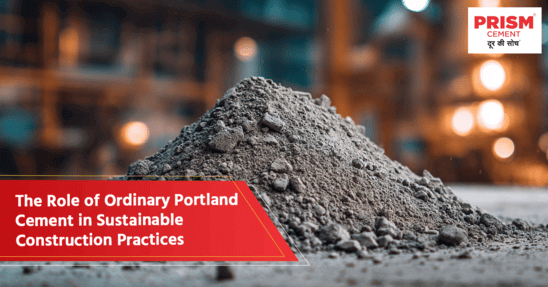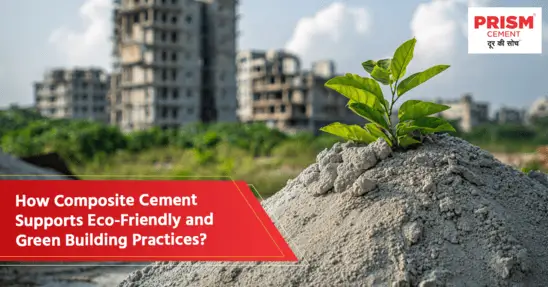Sustainable construction practices are becoming increasingly important as the world focuses on reducing its environmental impact. Building projects today must not only prioritize durability and functionality but also consider their ecological footprint. Ordinary Portland Cement (OPC), a key component of most construction materials, plays a significant role in this transition. As a widely used construction cement, OPC is integral to many modern buildings, but can it also contribute to sustainable construction?
Let’s explore how OPC Cement can support the growing demand for sustainable development while maintaining the strength and integrity of our built environment.
What Is Ordinary Portland Cement (OPC)?
Ordinary Portland Cement (OPC) is the most common type of cement used in the construction industry. It is made by heating limestone, clay and other raw materials to a high temperature to form clinker, which is then finely ground to produce OPC Cement. Known for its reliability, strength and versatility, OPC cement is used in everything from residential homes to large infrastructure projects.
While OPC cement is recognized for its essential role in construction, its environmental impact has garnered increasing attention in recent years. However, when used responsibly and combined with other materials, OPC Cement can play a part in sustainable construction practices.
Environmental Impact of Ordinary Portland Cement Production
The production of Ordinary Portland Cement is energy-intensive and has a considerable environmental impact. The primary concern is the high level of carbon dioxide (CO2) emissions released during the calcination of limestone in the cement-making process. It’s estimated that the production of OPC cement accounts for roughly 5-6% of global CO2 emissions.
However, this environmental footprint is not a reason to discard OPC Cement altogether. Instead, efforts are being made to reduce the carbon impact by improving production techniques and exploring ways to use OPC Cement more sustainably.
How Ordinary Portland Cement Can Support Sustainable Construction?
Despite its environmental impact, OPC Cement can still be part of sustainable construction through innovation and efficient practices. Companies like Prism Cement are continuously working towards making their products eco-friendly by reducing the carbon footprint during manufacturing.
One way to make OPC Cement more sustainable is by optimizing the cement production process, which involves reducing energy consumption and exploring alternative fuel sources. Using industrial by-products such as waste heat or biomass fuels can reduce reliance on traditional energy sources. Additionally, manufacturers are focusing on improving the efficiency of cement plants to minimize the environmental impact.
Enhancing the Durability and Lifespan of Structures
A crucial aspect of sustainable development is the durability of the structures we build. By improving the durability and lifespan of buildings, we reduce the need for frequent repairs or demolitions, thus conserving resources. OPC Cement contributes to the long-lasting strength of concrete, providing a foundation for buildings that can stand the test of time.
Concrete made with OPC has the inherent ability to absorb carbon dioxide (CO₂) from the atmosphere during its service life—a process known as recarbonation—which contributes to reducing its overall environmental impact.
Sustainable Projects Using Ordinary Portland Cement
There are numerous examples of sustainable projects that effectively incorporate OPC Cement. Prism Cement, for instance, contributes to sustainable construction by producing high-quality OPC Cement that meets environmental standards, enabling builders to create resilient and eco-friendly structures. By incorporating OPC Cement with SCMs, builders can reduce the environmental impact of their projects while ensuring the strength and longevity of their structures.
Many green buildings and infrastructure projects today rely on sustainable practices such as using OPC Cement with SCMs, efficient construction methods, and energy-saving designs. These projects prove that with the right strategies, OPC Cement can be part of a sustainable future.
Conclusion
Ordinary Portland Cement (OPC) continues to be a cornerstone of the construction industry, but its environmental impact is an area that cannot be ignored. While OPC cement production is energy-intensive and contributes to CO2 emissions, it can still play a role in sustainable construction.
By improving manufacturing processes, incorporating Supplementary Cementitious Materials (SCMs), and focusing on durability and longevity, OPC Cement can contribute to more sustainable building practices. At Prism Cement, we strive to create innovative solutions that can be an integral part of the move toward sustainable development.
FAQs
Q1. What is Ordinary Portland Cement (OPC), and why is it widely used in construction?
Answer: Ordinary Portland Cement (OPC) is a type of construction cement made by heating limestone and other materials to form clinker, which is then finely ground. It's widely used due to its strength, versatility and ability to bond with aggregates, making it ideal for a wide range of construction applications.
Q2. Can ordinary Portland cement be part of sustainable construction practices despite its environmental impact?
Answer: Yes, OPC Cement can be part of sustainable construction when used efficiently. Innovations in production, use of alternative fuels, blending with Supplementary Cementitious Materials (SCMs), and improving durability are all strategies that reduce their environmental impact.
Q3. What are some strategies to reduce the carbon footprint of ordinary Portland cement-based construction?
Answer: To reduce the carbon footprint, OPC Cement can be combined with SCMs like fly ash or slag, which lowers the amount of OPC Cement needed. Additionally, optimizing cement production processes, using alternative fuels, and focusing on durability and longevity can help reduce emissions.
Q4. Are there eco-friendly alternatives to ordinary Portland cement in construction?
Answer: Yes, eco-friendly alternatives to OPC Cement include Portland Pozzolana Cement (PPC), which incorporates fly ash, volcanic ash, and geopolymer cement. These alternatives can reduce the carbon footprint of construction and offer similar durability and strength.
Q5. How does the production of Ordinary Portland Cement impact the environment?
Answer: Ordinary Portland Cement production impacts the environment by emitting high levels of CO₂, consuming significant energy, and causing resource depletion, air pollution, and land degradation during raw material extraction and high-temperature kiln processes.




